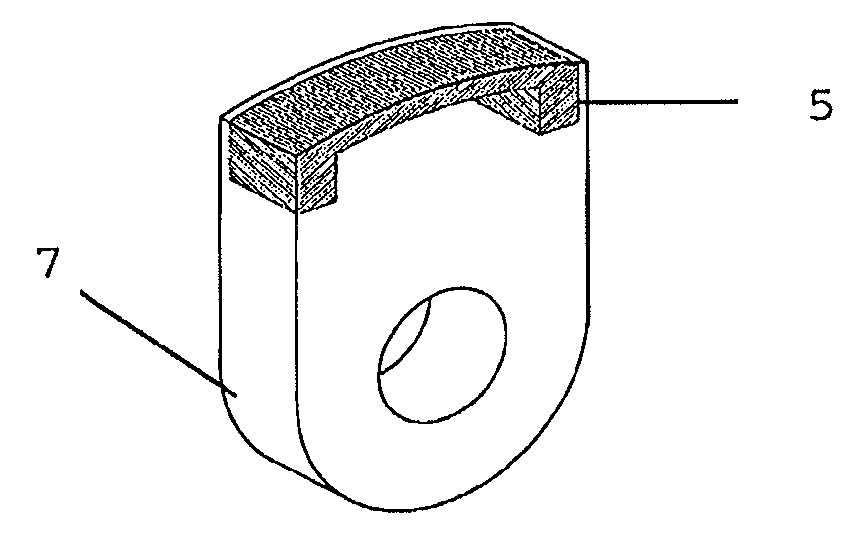Composite impactor for percussion crushers
a technology of percussion crusher and composite material, which is applied in the field of composite material impactor for percussion crusher, can solve the problems of not revealing a reinforcement structure and a durable bond
- Summary
- Abstract
- Description
- Claims
- Application Information
AI Technical Summary
Benefits of technology
Problems solved by technology
Method used
Image
Examples
example 1
[0092]In this example, the aim is to make an impactor, the reinforced areas of which comprise a global volume percentage of TiC of about 42%. For this purpose, a strip is made by compaction to 85% of the theoretical density of a mixture of C and of Ti. After crushing, the granules are sifted so as to obtain a dimension of granules located between 1.4 and 4 mm. A bulk density of the order of 2.1 g / cm3 is obtained (35% of space between the granules+15% of porosity in the granules).
[0093]The granules are positioned in the mold at the location of the portion to be reinforced which thus comprises 65% by volume of porous granules. A cast iron with chromium (3% C, 25% Cr) is then cast at about 1500° C. in a non-preheated sand mold. The reaction between the Ti and the C is initiated by the heat of the cast iron. This casting is carried out without any protective atmosphere. After reaction, in the reinforced portion, 65% by volume of areas with a high concentration of about 65% of globular t...
example 2
[0094]In this example, the aim is to make an impactor, the reinforced areas of which comprise a global volume percentage of TiC of about 30%. For this purpose, a strip is made by compaction to 70% of the theoretical density of a mixture of C and of Ti. After crushing, the granules are sifted so as to obtain a dimension of granules located between 1.4 and 4 mm. A bulk density of the order of 1.4 g / cm3 is obtained (45% of space between the granules+30% of porosity in the granules). The granules are positioned in the portion to be reinforced which thus comprises 55% by volume of porous granules. After reaction, in the reinforced portion, 55% by volume of areas with a high concentration of about 53% of globular titanium carbide are obtained, i.e. about 30% by the global volume of TiC in the reinforced portion of the impactor.
example 3
[0095]In this example, the aim is to make an impactor, the reinforced areas of which comprise a global volume percentage of TiC of about 20%. For this purpose, a strip is made by compaction to 60% of the theoretical density of a mixture of C and of Ti. After crushing, the granules are sifted so as to obtain a dimension of granules located between 1 and 6 mm. A bulk density of the order of 1.0 g / cm3 is obtained (55% of space between the granules+40% of porosity in the granules). The granules are positioned in the portion to be reinforced which thus comprises 45% by volume of porous granules. After reaction, in the reinforced portion, 45% by volume of areas concentrated to about 45% of globular titanium carbide are obtained, i.e. 20% of the global volume of TiC in the reinforced portion of the impactor.
PUM
| Property | Measurement | Unit |
|---|---|---|
| Length | aaaaa | aaaaa |
| Length | aaaaa | aaaaa |
| Length | aaaaa | aaaaa |
Abstract
Description
Claims
Application Information
 Login to View More
Login to View More - R&D
- Intellectual Property
- Life Sciences
- Materials
- Tech Scout
- Unparalleled Data Quality
- Higher Quality Content
- 60% Fewer Hallucinations
Browse by: Latest US Patents, China's latest patents, Technical Efficacy Thesaurus, Application Domain, Technology Topic, Popular Technical Reports.
© 2025 PatSnap. All rights reserved.Legal|Privacy policy|Modern Slavery Act Transparency Statement|Sitemap|About US| Contact US: help@patsnap.com



